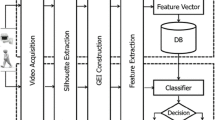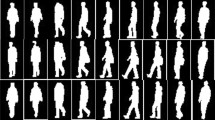Abstract
A gender balanced dataset of 101 pedestrians on a treadmill is presented. Gait is analysed for gender classification using a modification of a framework which has previously proven effective when used in behaviour recognition experiments. Sparse spatio temporal features from the video clips are classified using Support Vector Machines. Tuning parameters are investigated to find an effective feature descriptor for gender separation and an accuracy of 87% is achieved.
Access this chapter
Tax calculation will be finalised at checkout
Purchases are for personal use only
Preview
Unable to display preview. Download preview PDF.
Similar content being viewed by others
References
Dollár, P., Rabaud, V., Cottrell, G., Belongie, S.: Behavior recognition via sparse spatio-temporal features. In: VS-PETS (October 2005)
Collins, M., Zhang, J., Miller, P., Wang, H.: Full body image feature representations for gender profiling. In: IEEE Workshop on Visual Surveillance, ICCV (2009)
Collins, M., Zhang, J., Miller, P., Wang, H., Zhou, H.: Eigenbody: Analysis of body shape for gender from noisy images. In: IMVIP, University of Limerick, Cambridge Publications (2010)
Mather, G., Murdoch, L.: Gender discrimination in biological motion displays based on dynamic cues. Proc. R. Soc. B 258(1353), 273–279 (1994)
Pollick, F.E., Kay, J.W., Heim, K., Stringer, R.: Gender recognition from point-light walkers. J. Exp. Psychol. [Hum. Percept.] 31(6), 1247–1265 (2005)
Troje, N.F.: Decomposing biological motion: a framework for analysis and synthesis of human gait patterns. J. Vis. 2(5), 371–387 (2002)
Barclay, C.D., Cutting, J.E., Kozlowski, L.T.: Temporal and spatial factors in gait perception that influence gender recognition. Percept. Psychophys. 23(2), 145–152, 643509 (1978)
Yoo, J.-H., Hwang, D., Nixon, M.S.: Gender classification in human gait using support vector machine. In: Blanc-Talon, J., Philips, W., Popescu, D.C., Scheunders, P. (eds.) ACIVS 2005. LNCS, vol. 3708, pp. 138–145. Springer, Heidelberg (2005)
Ng, C.B., Tay, Y.H., Goi, B.M.: Vision-based human gender recognition: A survey. CoRR abs/1204.1611 (2012)
Shan, C., Gong, S., McOwan, P.W.: Fusing gait and face cues for human gender recognition. Neurocomput. 71(10-12), 1931–1938 (2008)
Yu, S., Tan, D., Tan, T.: A framework for evaluating the effect of view angle, clothing and carrying condition on gait recognition. In: ICPR, vol. 4, 441–444 (2006); ID: 1
Zheng, S., Zhang, J., Huang, K., He, R., Tan, T.: Robust view transformation model for gait recognition. In: ICIP, pp. 2073–2076 (2011); ID: 1
Author information
Authors and Affiliations
Editor information
Editors and Affiliations
Rights and permissions
Copyright information
© 2014 Springer International Publishing Switzerland
About this paper
Cite this paper
Collins, M., Miller, P., Zhang, J. (2014). Gait Based Gender Recognition Using Sparse Spatio Temporal Features. In: Gurrin, C., Hopfgartner, F., Hurst, W., Johansen, H., Lee, H., O’Connor, N. (eds) MultiMedia Modeling. MMM 2014. Lecture Notes in Computer Science, vol 8326. Springer, Cham. https://doi.org/10.1007/978-3-319-04117-9_8
Download citation
DOI: https://doi.org/10.1007/978-3-319-04117-9_8
Publisher Name: Springer, Cham
Print ISBN: 978-3-319-04116-2
Online ISBN: 978-3-319-04117-9
eBook Packages: Computer ScienceComputer Science (R0)




